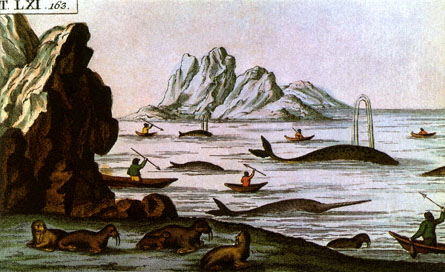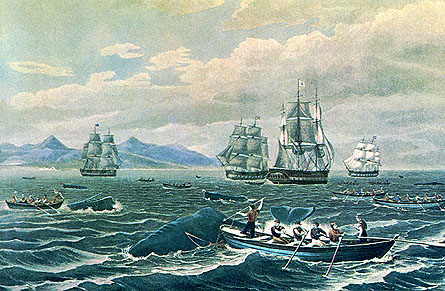

Our planet is truly a
world of water.
About 75% of Earth's surface is
covered by water, with about 71% of the Earth being covered by oceans
alone! All of the oceans of the Earth are
continuous, which means that they
are interconnected. this has some profound ecological importance.
Unlike a lake or a pond, which may be severely polluted and still not
affect other lakes and ponds, the oceans of the world are part of
one, really large, body of water. What you do to one part, you do to
all parts. No section of the ocean is completely isolated from any of
the other sections. We
need to be very careful about what we do to our little part of the
ocean, because our little part of the ocean is directly connected to
all of the other little parts of the ocean, all over the
world. There are 320 million
cubic miles of water on Earth and that is all we're ever going to
get. The system is closed, nothing can be added or
subrtracted. This water realm is called the Hydropshere, and it
is overwhelmingly oceanic. 97% of all water on Earth is in the
seas, the greater part of it in the Pacific, which covers half the
planet and is bigger than all the landmasses put together.
The largest ocean in the world is the
Pacific,
it is also the deepest ocean on the planet, having an average depth
of 3,940 meters! (Roughly 12,000 feet, or about 2
1/2 miles!!!) The next largest
oceans are the Atlantic
and the Indian
oceans. The Atlantic ocean is
larger, but shallower than the Indian ocean. By the way, the term
"sea"
refers to a part of an ocean almost
completely surrounded by land. If a sea is ever completely cut off
from the rest of the ocean, it ceases to be a sea and will be known
simply as a large, saltwater, inland lake. Although the Pacific
holds over half of the water (51.6%), the Atlantic has 23.6% and the
Indian Ocean has 21.2%, leaving just 3.6%
to be accounted for by all the other seas.

Salinity: Of course, the most obvious characteristic of an ocean is that it is salty. SALINITY is the term used to describe the amount of dissolved salts that are found in ocean water. Salinity is measured in units called PARTS PER THOUSAND or ppt. This tells how how many parts, out of a thousand parts, will be made out of salt. The average salinity of the world's oceans is 35ppt. This means that if you want to make ocean water, you must add 35 parts of salt, and 965 parts of pure water, (total is 1000 parts, get it?). That may not seem like all that much salt, but that's all there is! Next time you get a chance, maybe on a field trip....TASTE some real ocean water (especially if you haven't before), you will find that 35 parts of salt and 965 parts freshwater still tastes pretty salty! Because local conditions can affect the salinity of ocean water, all parts do not share exactly the same salinity. The range of salinity for all the Earth's oceans is between 33ppt and 37ppt. Various factors like the rate of evaporation, amount of rainfall, quantity of rivers and streams in the area, can all have an effect on the salinity of the ocean in an area. Some areas of the world have weather conditions which tend to increase or decrease the salinity of the local oceans and seas. Equatorial areas, which have a high rate of evaporation, do not experience much precipitation and have few incoming freshwater rivers, tend to have a salinity that is higher than average (closer to 37ppt). Other areas, like the Gulf of Maine, have local conditions which tend to reduce the salinity of the oceans nearby. Conditions such as a low rate of evaporation, a high precipitation rate and a large number of freshwater rivers dumping their water into the ocean, tends to make these areas have a slightly lower than average salinity (closer to 33ppt).
The most common type of salt in the ocean is plain old table salt, whose chemical symbol is NaCl. Other types of salts present include Magnesium Chloride, Magnesium Sulfate and Calcium Sulfate. We need salt to live, but only in very small amounts, and seawater contains about seventy times more salt than we can safely metabolize. A typical liter of seawater will contain only about 2.5 teaspoons of salt (NaCl), but much larger amounts of other elements, compounds and dissolved solids, which are collectively known as "salts". All in all, about 85 different elements have been discovered dissolved in our oceans. The Chlorine and Sodium from NaCl account for most of the elements dissolved though. The other most plentiful elements in the ocean are; magnesium, sulfur, calcium, potassium, bromine, carbon, silicon, fluorine, aluminum and iodine.
Of course, the big question
is
how the oceans got
so salty
in the first place. Think of it.
When oceans were first formed on Earth, they were composed entirely
of freshwater.
Over the past several billion years, the ocean's salinity has been
slowly increasing. The processes of EROSION
AND EVAPORATION are
responsible. When freshwater runs over the surface of the land, it
dissolves various minerals and carries them to the ocean. Once in the
ocean, large quantities of water evaporate every day. When water
evaporates, it is unable to carry the salt with it, so the salt is
left behind. The evaporation of water contributes to the salinity of
the ocean in other ways as well. When water flows over the land,
one of the elements that is dissolved is called Sodium. This
sodium is deposited in the ocean along with the other minerals
dissolved. Underwater volcanoes produce large quantities of the
element Chlorine, which also ends up in the ocean. The
evaporation of water brings the sodium and chlorine atoms together, to
form Sodium Chloride (NaCl), the most common form of salt in the
ocean. The evaporated water eventually rains down upon the land
once more, and once again makes it's trek to the ocean, picking up
various minerals and salts along the way again. Again it empties into
the ocean, is evaporated and leaves its accumulated minerals behind.
In this way the salinity of the ocean slowly increased as time passed.
Eventually, the ocean will reached a balanced salinity, where
the
amount of new salt brought in was counterbalanced by the amount
of precipitation that the ocean receives. Various other mechanisms also
serve to remove salt from the ocean water. Many creatures build
shells in which to live. These shells can protect them from
predators and the harshness of the ocean environment. These
shells are mostly composed of Calcium, an element found in the salt CaCl2,
another form of salt in the oceans of the world.
It is important to realize
that the ocean's salinity is somewhat more stable in deeper portions
of the ocean. this comes about because deep water is less influenced
by things like input from freshwater rivers, precipitation and
evaporation.

Gases in Ocean Water: The most abundant gases in ocean water are, in order of their abundance, Carbon Dioxide, Nitrogen and Oxygen. All of the other atmospheric gases are also found dissolved in ocean water. It is interesting to note that temperature has a great effect upon the amount of gases that may be present in the water. The relationship is a simple one, COLD WATER CAN HOLD MORE DISSOLVED GASES THAN CAN WARMER WATER. Try this simple experiment. Take a glass of cold water with you tonight when you go to bed. Leave the glass out on the night stand overnight. As the water warms up, it isn't able to hold as much gas as it could when it was cooler and just out of the faucet, and, because of this, tiny bubbles will appear and cling to the inside of the glass. If you put this glass carefully into a refrigerator, as the water cools, it will be able to hold more gases than the warmer water could, and the bubbles will be reabsorbed.